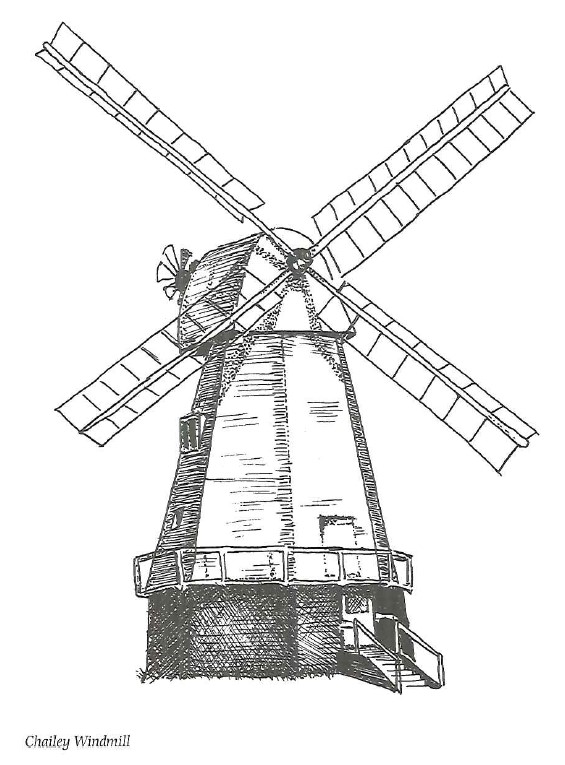The tale of the cannibal ogre has persisted for 400 years. Sir Goddard Oxenbridge, a towering 16th century knight, was said to eat a child every night for his supper. He could not be harmed by conventional weapons but was vulnerable to anything made of wood.
The children of Sussex held a council for self-protection and hit upon a plan. They persuaded the giant to become stupefied with drink and then sawed him in half with a massive wooden saw, the children of East Sussex riding on one end and their West Sussex Cousins on the other.
The scene of the infants’ deliverance, between Brede Place and the church, became known as Groaning Bridge and was haunted by the ghost of Sir Goddard. No doubt the story served two purposes: As a warning to naughty children from exasperated Brede mothers that the giant would have them on his plate, and an intimidating legend with which smugglers could scare away the curious from the nocturnal goings-on at Brede Place which they used as a headquarters.
But tales of the ghost and reports of strange noises at Groaning Bridge were well enough authenticated for the Psychical Research Society to take some interest in it at the beginning of the 20th century. Poor old Sir Goddard lies in a tomb bearing his armoured effigy in the church he helped to build for the village, remembered still for his dining habits rather than his generosity.
Brede Place, which dates from the 14th century and is still sometimes referred to locally as the Giant’s House, has another supernatural story. Alterations 300 years ago cut off the altar area of the chapel, disturbing the spirit of a priest who once lived there and who still haunts the spot where the altar used to be.
The house was rented for a time by Stephen Crane, author of The Red Badge of Courage (remember Audie Murphy in the film version?), and the sculptress Clare Sheridan also lived here. She carved a madonna from the trunk of an oak tree which is among the treasures of the church.
The village, pleasantly situated on a southern slope tumbling down to the small river which bears its name, was famous for its iron works, making cannon and shot until the bottom fell out of the Sussex iron trade. Brede went over to the manufacture of gunpowder in the 18th century and William Sinden was ‘blown into five parts from the sudden explosure (sic) of Brede Gunpowder Mills, March 7, 1808.’ Was he perhaps smoking on the job?
The vicar once found the actress Ellen Terry having a picnic lunch in the churchyard: The most cheerful churchyard I ever knew,’ she told him. But it has a relic of a tragic Victorian love story in the form of a small oak cross bearing the single word “Damaris’. Damaris Richardson lived with her uncle in a modest cottage in Rectory Lane. She was a beautiful orphan who worked at the rectory and in a small residential school operated by Rev Maher to supplement his income. She fell in love with Lewis Smith, the handsome young son and sole heir of a wealthy Brede landowner, and they would meet in secret at the west wall of the churchyard – she on the graveyard side and Lewis on the other, in the grounds of the big house where he lived with his parents.
They soon agreed to become unofficially engaged. But affairs are hard to conceal in a small village community and Somebody told Lewis’ father of the clandestine meetings. He angrily forbade any ideas of marriage – beautiful, charming and respectable Damaris might be, but she stood far below the station of the Smith family. Lewis, threatened with being cut off without a shilling, gave way to his father.
Presumably there was one final meeting of farewell beside the wall before they parted forever. Damaris, they say, died of a broken heart at the age of 22 and was buried near the trysting place on 4 September 1856. Her grave was unmarked until the Rev Aylward, who years later succeeded Mr Maher as rector of Brede and remembered the orphan from his days as a pupil at the village’s school, commissioned the erection of the cross. Lewis Smith never married, living alone and withdrawn in the big house he inherited. Villagers said he was often to be seen walking gravely in the gardens, close to the wall. He died, aged 64, on 23 February 1896 and was interred in the Smith family tomb on the north side of the church. At one time the church housed the cradle of Jonathan Swift, having been bought at a Brighton curio sale.
